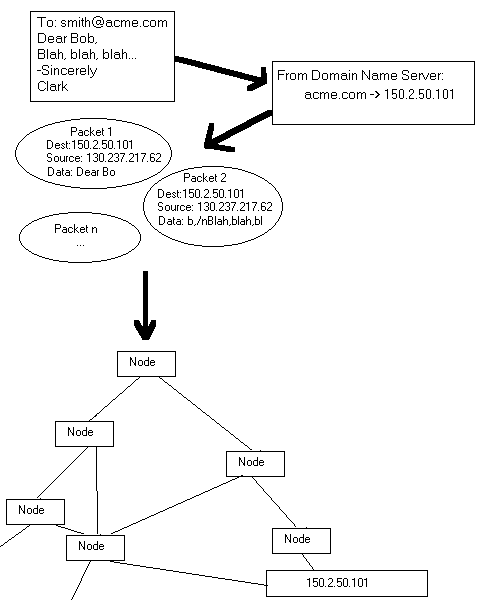
| Home : Course Map : Chapter 13 : |
|
Internet Basics
|
| JavaTech |
| Course Map |
| Chapter 13 |
|
Network
Overview |
| About
JavaTech Codes List Exercises Feedback References Resources Tips Topic Index Course Guide What's New |
|
As mentioned in the previous section, the Internet refers to the TCP & IP protocols used in the Transport and Network layers, respectively. See the network layers diagram. The diagram below shows how the TCP and IP layers split an email into groups of bytes called packets. A packet contains a header with the destination and source addresses and and miscellaneous other information such as error correction bytes. (We dicusss the IP address format later.) The body of the packet contsists of the data payload. These packets are sent through through the network towards there destination. At the nodes of the network, there are devices called routers. The routers read the destination addresses on the packets and send the packet to the next node closest to the final destination, just as a letter in the postal delivery system is passed along to the next node nearest the final address. If a node doesn't respond or if the traffic load needs balancing, the transmitting node looks for alternate routes. When the packets reach their final destination, the original message is rebuilt. The packets may arrive out of order so the rebuilding must wait for all packets to arrive.
The above figure sketches the packet's travels through the network. A node in the local area network (LAN) could be another computer or a dedicated router, which is essentially a computer dedicated to packet transmission. A router receives packets from different nodes and sends them to the proper destination. Typically the local router sends the packet to an internet service provider (ISP), such as a DSL or cable internet system, which is connected to the Internet backbone. The backbone uses very high speed, high capacity routers and fibers to send the packet to the ISP closest to the destination. From there the packet works its way to the destination computer, which might lie inside a LAN, which might in turn connect to a a WAN (wide area network) such as on a computer campus. The header consists of a destination address, source address, and other miscellaneous info such as error correction bytes. Routers read the destination address and send the packet to the next link determined to be the shortest path. This path can vary if, for example, the router determines that a previously chosen link has too much traffic or the router at the other end of the link is not responding. Latest update: Dec. 8, 2004 |
